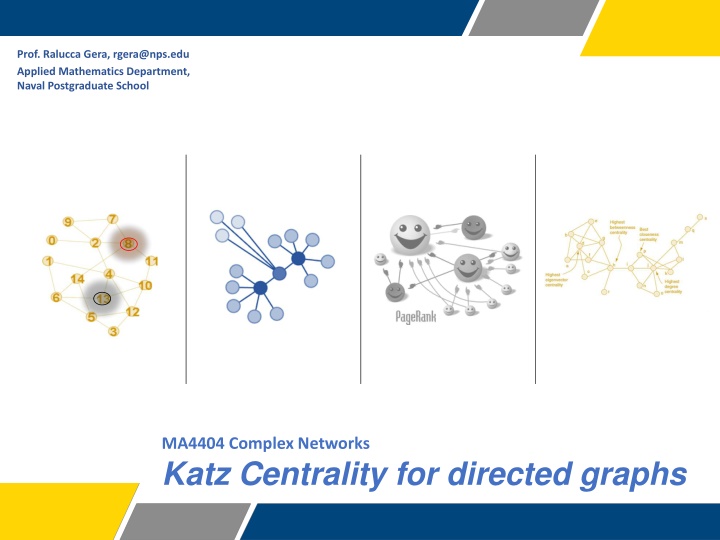
Understanding Katz Centrality for Directed Graphs
Gain insights into Katz centrality as an extension of Eigenvector Centrality for directed graphs, compute centrality per node, interpret the values, and explore adaptations for non-strongly connected graphs. Discover solutions for nodes with zero in-degree and the augmentation technique to include them in calculations.
Download Presentation

Please find below an Image/Link to download the presentation.
The content on the website is provided AS IS for your information and personal use only. It may not be sold, licensed, or shared on other websites without obtaining consent from the author. If you encounter any issues during the download, it is possible that the publisher has removed the file from their server.
You are allowed to download the files provided on this website for personal or commercial use, subject to the condition that they are used lawfully. All files are the property of their respective owners.
The content on the website is provided AS IS for your information and personal use only. It may not be sold, licensed, or shared on other websites without obtaining consent from the author.
E N D
Presentation Transcript
Prof. Ralucca Gera, rgera@nps.edu Applied Mathematics Department, Excellence Through Knowledge Naval Postgraduate School MA4404 Complex Networks Katz Centrality for directed graphs
Understand how Katz centrality is an extension of Eigenvector Centrality to directed graphs. Compute Katz centrality per node. Interpret the meaning of the values of Katz centrality. Learning Outcomes
Recall: Centralities Quality: what makes a node important (central) Mathematical Description Appropriate Usage Identification Lots of one-hop connections from ? The number of vertices that ? influences directly Local influence matters Small diameter Degree deg(?) Lots of one-hop connections from ? relative to the size of the graph The proportion of the vertices that ? influences directly Local influence matters Small diameter Degree centrality deg(?) |V(G)| Ci= Lots of one-hop connections to high centrality vertices A weighted degree centrality based on the weight of the neighbors (instead of a weight of 1 as in degree centrality) For example, when the people you are connected to matter. Eigenvector centrality (recursive formula): ?? ?? j What changes in directed graphs?!
Recall: Strongly connected Definition: A directed graph D = (V, E) is strongly connected if and only if, for each pair of nodes u, v V, there is a path from u to v. How do we compute centralities if the graph is not strongly connected? For example, the Web graph is not strongly connected since there are pairs of nodes u and v, there is no path from u to v and from v to u. This presents a challenge for nodes that have an in-degree of zero Why? What is the cascading effect? What is a solution? v u http://en.wikipedia.org/wiki/Directed_acyclic_graph 4
Katz Centrality Recall that the eigenvector centrality ? ? is a weighted degree obtained from the leading eigenvector of A: A x ? = 1x ? , so its entries are ??=1 1 ? Thoughts on how to adapt the above formula for directed graphs (maybe not all being strongly connected)? 1 1 ?????? + , where is a constant initial weight given to each vertex so that vertices with zero in degree (or out degree) are included in calculations. After this augmentation, a random surfer on a particular webpage, has two options: He randomly chooses an out-link to follow (???) He jumps to a random page ( ) ????? Katz centrality: ??= Does have to be the same for each vertex? An extension: ? is an initial weight given to vertex ? as a mechanism to differentiate vertices using some quality not modeled by adjacencies. Vertices with zero in degree (or out degree) will be included in calculations.
Katz Centrality Does Generalize the concept of eigenvector centrality to directed networks that are not strongly connected Does not Control for the fact that a high centrality vertex imparts high centrality on those vertices downstream, or all those vertices reachable from that high centrality vertex PageRank 6
Updated Overview: Quality: what makes a node important (central) Mathematical Description Appropriate Usage Identification Lots of one-hop connections relative to the size of the graph The proportion of the vertices that ? influences directly Local influence matters Small diameter Normalized degree centrality Ci= deg(i) Lots of one-hop connections to high centrality vertices A weighted degree centrality based on the weight of the neighbors For example when the people you are connected to matter. Eigenvector centrality ?? ?? j Lots of one-hop connections to high out-degree vertices (where each vertex has some pre- assigned weight) A weighted degree centrality based on the out degree of the neighbors Directed graphs that are not strongly connected Katz centrality ??= Where is some initial weight 1 1 ?????? + ,
